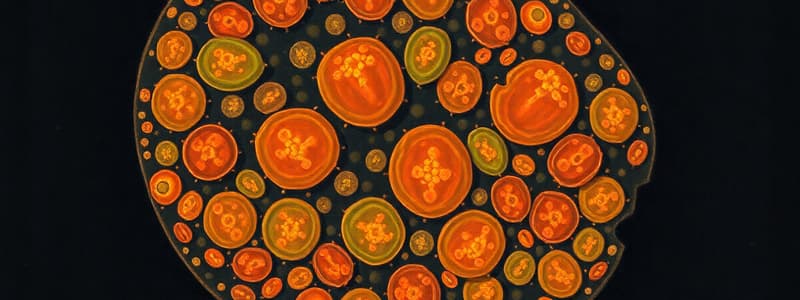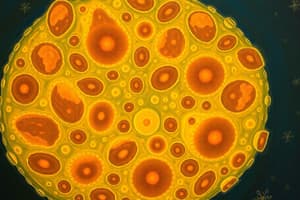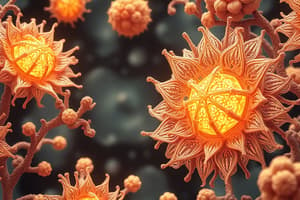Podcast
Questions and Answers
Why are protists not considered a taxonomic clade?
Why are protists not considered a taxonomic clade?
- They do not share a unique common ancestor; it is a paraphyletic group. (correct)
- They are all prokaryotic cells.
- They all have identical cellular structures and functions.
- They are all multicellular organisms.
Which of the following characteristics is common among most protists?
Which of the following characteristics is common among most protists?
- Multicellularity with specialized tissues
- Prokaryotic cellular structure
- Autotrophic nutrition via photosynthesis
- Unicellularity and eukaryotic organization (correct)
What evolutionary event is indicated by the presence of protists having sister clades to multicellular organisms?
What evolutionary event is indicated by the presence of protists having sister clades to multicellular organisms?
- Multicellularity evolved multiple times independently (correct)
- Protists are evolving into prokaryotes
- Prokaryotes are evolving into protists
- A single origin of multicellularity within protists
What cellular characteristics differentiate eukaryotes like protists from prokaryotes?
What cellular characteristics differentiate eukaryotes like protists from prokaryotes?
What is the significance of endosymbiosis in protist evolution?
What is the significance of endosymbiosis in protist evolution?
Which event occurred first in the evolution of eukaryotic cells according to the endosymbiotic theory?
Which event occurred first in the evolution of eukaryotic cells according to the endosymbiotic theory?
What protist lineages evolved into photosynthetic protists, leading to red and green algae?
What protist lineages evolved into photosynthetic protists, leading to red and green algae?
Which characteristic is associated with rhizarian amoebas?
Which characteristic is associated with rhizarian amoebas?
What roles do rhizarians play in ecological and geological studies?
What roles do rhizarians play in ecological and geological studies?
How do amoebas belonging to the rhizarian clade move and feed?
How do amoebas belonging to the rhizarian clade move and feed?
Which of the following describes the 'SAR' clade?
Which of the following describes the 'SAR' clade?
What are the major clades that make up the 'SAR' clade?
What are the major clades that make up the 'SAR' clade?
Diplomonads are a group of protists characterized by which feature?
Diplomonads are a group of protists characterized by which feature?
What is a key characteristic of Giardia intestinalis, a member of the Excavata?
What is a key characteristic of Giardia intestinalis, a member of the Excavata?
Which supergroup includes animals and fungi?
Which supergroup includes animals and fungi?
In secondary endosymbiosis, what is engulfed by a heterotrophic eukaryote?
In secondary endosymbiosis, what is engulfed by a heterotrophic eukaryote?
Which eukaryotic supergroup includes red algae, green algae, and land plants?
Which eukaryotic supergroup includes red algae, green algae, and land plants?
What feature is essential for a cell to be considered multicellular?
What feature is essential for a cell to be considered multicellular?
Which of the following statements best describes protists?
Which of the following statements best describes protists?
What is the origin of plastids?
What is the origin of plastids?
What distinguishes secondary endosymbiosis from primary endosymbiosis?
What distinguishes secondary endosymbiosis from primary endosymbiosis?
What structural adaptation is characteristic of Stentor coeruleus for predation?
What structural adaptation is characteristic of Stentor coeruleus for predation?
How might the ability of Giardia cysts to survive for extended periods in cold water affect public health?
How might the ability of Giardia cysts to survive for extended periods in cold water affect public health?
Why is the "SAR" clade considered a controversial grouping among protists?
Why is the "SAR" clade considered a controversial grouping among protists?
What allows the trophozoite form of Giardia to actively feed and move?
What allows the trophozoite form of Giardia to actively feed and move?
Why is multicellularity considered to have evolved multiple times?
Why is multicellularity considered to have evolved multiple times?
Which of the following is a consequence of secondary endosymbiosis?
Which of the following is a consequence of secondary endosymbiosis?
Where do Giardia intestinalis parasites commonly colonize in a mammalian host?
Where do Giardia intestinalis parasites commonly colonize in a mammalian host?
The pseudopodia in Rhizarians serve primarily for what purposes?
The pseudopodia in Rhizarians serve primarily for what purposes?
What best describes the role of the ancestral host cell in endosymbiosis?
What best describes the role of the ancestral host cell in endosymbiosis?
Diatoms, a type of algae within the stramenopiles, are significant for what ecological contribution?
Diatoms, a type of algae within the stramenopiles, are significant for what ecological contribution?
What is the evolutionary relationship between land plants and green algae?
What is the evolutionary relationship between land plants and green algae?
How does the presence of a nucleomorph support the theory of secondary endosymbiosis?
How does the presence of a nucleomorph support the theory of secondary endosymbiosis?
What is the importance of cell cohesion in the development of multicellularity?
What is the importance of cell cohesion in the development of multicellularity?
Which of the following conditions is associated with diarrheal disease outbreaks due to contaminated water sources?
Which of the following conditions is associated with diarrheal disease outbreaks due to contaminated water sources?
Why are protists considered a diverse group in terms of their ecological roles?
Why are protists considered a diverse group in terms of their ecological roles?
Which process is responsible for the bioluminescence observed in certain dinoflagellates?
Which process is responsible for the bioluminescence observed in certain dinoflagellates?
What makes Volvox a colonial organism rather than a truly multicellular organism?
What makes Volvox a colonial organism rather than a truly multicellular organism?
Flashcards
What are protists?
What are protists?
Eukaryotes that are not plants, animals, or fungi; a diverse group of mostly unicellular organisms.
What is the cellularity of most protists?
What is the cellularity of most protists?
Single-celled eukaryotes.
What is the SAR clade?
What is the SAR clade?
A large and diverse monophyletic group of protists including stramenopiles, alveolates, and rhizarians.
What are amoebas?
What are amoebas?
Signup and view all the flashcards
How did mitochondria and plastids evolve?
How did mitochondria and plastids evolve?
Signup and view all the flashcards
What is primary endosymbiosis?
What is primary endosymbiosis?
Signup and view all the flashcards
What is secondary endosymbiosis?
What is secondary endosymbiosis?
Signup and view all the flashcards
What is the Unikont clade?
What is the Unikont clade?
Signup and view all the flashcards
What is Giardia intestinalis?
What is Giardia intestinalis?
Signup and view all the flashcards
What are pseudopodia?
What are pseudopodia?
Signup and view all the flashcards
What disease does Giardia cause?
What disease does Giardia cause?
Signup and view all the flashcards
What is the life cycle of Giardia?
What is the life cycle of Giardia?
Signup and view all the flashcards
Study Notes
- Protists are not a taxonomic clade
- Protists are single celled eukaryotes
- Multicellularity evolved multiple times among protists
- Some protists have sister clades to multicellular organisms
- Some protists are predatory
Eukaryotic Cells
- Protists are eukaryotes
- Eukaryotic cells are more complex than prokaryotic cells, due to the presence of organelles
- Most eukaryotic lineages include protists
- Most protists are unicellular
Protist Diversity
- Excavata includes Giardia, which has two nuclei, and is a diplomonad parasite with detailed surface
- SAR clade is diverse
- Archaeplastida includes volvox, which is obligate colonial, and lives in colonies in freshwater
- Unikonta includes amoebas
- Internal membranes bound organelles and mitosis (instead of binary fission) are unique to eukaryotes
- Eukaryotes include excavata, SAR clade, archaeplastida, and unikonts
- Excavata and "SAR" clade are single celled
- Archaeplastida and unikonts can be multi or single celled
- To be multicellular requires:
- Cell communication
- Specialization
- Mitosis
- Altruism
- Cell cohesion: Caherins
- Dinoflagellates are bioluminescent
- Rhizarians are used in fossil records to track extinctions and ocean temperature changes
- Plastids within photosynthetic rhizarians contain a chromatophore
Endosymbiosis
- Mitochondria and plastids are derived from prokaryotes
- Prokaryotes were engulfed by the ancestors of early eukaryotic cells
- Mitochondria evolved once via endosymbiosis of an alpha proteobacterium
- Plastids evolved later via endosymbiosis of a photosynthetic cyanobacterium
- The ancestral host cell may have been an archaean or a "protoeukaryote"
- The plastid-bearing lineage of protists evolved into red and green algae
- Primary endosymbiosis involves a heterotrophic eukaryote engulfing cyanobacterium, which results in red and green algae
- Secondary endosymbiosis consumes something else, which it keeps
SAR Clade
- The "SAR" clade is a diverse monophyletic supergroup
- Named for the first letters of its three major clades: stramenopiles, alveolates, and rhizarians
- It is one of the most controversial of the four supergroups
- Diatoms are stramenopiles that produce most of the O2
- Many species in the rhizarian clade are amoebas
- Amoebas move and feed by pseudopodia (extensions of the cell surface)
- Rhizarian amoebas differ from amoebas in other clades by having threadlike pseudopodia
- Rhizarians include radiolarians, forams, and cercozoans
Giardia
- Giardia causes disease
- It is commonly found in H2O
- It is found in hamster intestines
- The surface is coated by parasites that aid digestion
- The Giardia cysts can survive for weeks to months in cold water
- Cysts (not adults) are capable of surviving outside of the host
- Both cysts and trophozoites are found in feces
- Only about a third of infected people exhibit symptoms
- Rhizarians are not parasites in humans, but excavates are – including Giardia
Studying That Suits You
Use AI to generate personalized quizzes and flashcards to suit your learning preferences.




